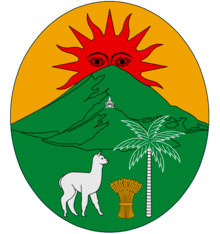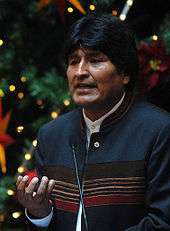History of Bolivia (1982–present)
Part of a series on the |
|---|
| History of Bolivia |
 |
|
|
The history of Bolivia since 1982 begins with the restorations of democracy after the rule of the military junta of 1982. Evo Morales has held the presidency since 2006. A new constitution was enacted in 2009. Bolivia's population has roughly doubled over this period, from 5 million in 1980 to 10 million as of 2012.
Hernán Siles Zuaso (1982–85)
The former president Hernán Siles Zuazo assumed the presidency of Bolivia on 10 October 1982,[1] following a general strike that brought the country close to civil war. Severe social tension, exacerbated by economic mismanagement and weak leadership, forced Siles Zuaso to call early elections and relinquish power a year before the end of his constitutional term.
Víctor Paz Estenssoro (1985–1989)
In the 1985 elections, the Nationalist Democratic Action (ADN) of General Hugo Banzer Suárez won a plurality of the popular vote, followed by former President Víctor Paz Estenssoro's Nationalist Revolutionary Movement (MNR) and former Vice President Jaime Paz Zamora's Revolutionary Left Movement (MIR). But in the congressional run-off, the MIR sided with the MNR, and Paz Estenssoro was chosen for a fourth term as President. When he took office in 1985, he faced a staggering economic crisis. Economic output and exports had been declining for several years.
Hyperinflation had reached an annual rate of 24%. Social unrest, chronic strikes, and unchecked drug trafficking were widespread. In 4 years Paz Estenssoro's administration achieved economic and social stability. The military stayed out of politics, and all major political parties publicly and institutionally committed themselves to democracy. Human rights violations, which badly tainted some governments earlier in the decade, were no longer a problem. However, his remarkable accomplishments were not won without sacrifice. The collapse of tin prices in October 1985, coming just as the government was moving to reassert its control of the mismanaged state mining enterprise, forced the government to lay off over 20,000 miners.
Under pressure from the United States to control coca production, Bolivia passed Law 1008 to enable eradication. Protests by coca growers in Chapare against the proposed law were met by the Villa Tunari massacre in which 12 farmers were killed.[2]
Jaime Paz Zamora (1989-1993)
Although the MNR list headed by Gonzalo Sánchez de Lozada finished first in the 1989 elections, no candidate received a majority of popular vote and in accordance with the constitution, a congressional vote determined who would be president. The Patriotic Accord (AP) coalition between Gen. Banzer's ADN and Jaime Paz Zamora's MIR, the second- and third-place finishers, respectively, won. Paz Zamora assumed the presidency, and the MIR took half the ministries. Banzer's center-right ADN took control of the National Political Council (CONAP) and the other ministries.
Paz Zamora was a moderate, center-left President whose political pragmatism in office outweighed his Marxist origins. Having seen the destructive hyperinflation of the Siles Zuazo administration, he continued the neoliberal economic reforms begun by Paz Estenssoro, codifying some of them. Paz Zamora took a fairly hard line against domestic terrorism, personally ordering the December 1990 attack on terrorists of the Néstor Paz Zamora Commission.
Paz Zamora was less decisive against narcotics trafficking. The government broke up a number of trafficking networks but issued a 1991 surrender decree giving lenient sentences to the biggest narcotics kingpins. Also, his administration was extremely reluctant to pursue coca eradication. It did not agree to an updated extradition treaty with the US, although two traffickers have been extradited to the U.S. since 1992. Beginning in early 1994, the Bolivian Congress investigated Paz Zamora's personal ties to accused major trafficker Isaac Chavarria, who subsequently died in prison while awaiting trial. MIR deputy chief Oscar Eid was jailed in connection with similar ties in 1994; he was found guilty and sentenced to 4 years in prison in November 1996. Technically still under investigation, Paz Zamora became an active presidential candidate in 1996.
Gonzalo Sánchez de Lozada (1993-1997)
The 1993 elections continued the tradition of open, honest elections and peaceful democratic transitions of power. The MNR defeated the ADN/MIR coalition by a 36% to 20% margin, and the MNR's Sánchez de Lozada was selected as president by a Congressional coalition of the MNR, Free Bolivia Movement (Movimiento Bolivia Libre, MBL), and Civic Solidarity Union (Unidad Cívica Solidaridad, UCS).
Sánchez de Lozada pursued an aggressive economic and social reform agenda. The most dramatic change undertaken by the Sanchez de Lozada government was the capitalization program, under which investors acquired 50% ownership and management control of public enterprises, such as the Yacimientos Petroliferos Fiscales Bolivianos (YPFB) oil corporation, telecommunications system, electric utilities, and others. The reforms and economic restructuring were strongly opposed by certain segments of society, which instigated frequent social disturbances, particularly in La Paz and the Chapare coca-growing region, from 1994 through 1996.
Hugo Banzer Suárez (1997-2001)
In the 1997 elections, Gen. Hugo Banzer, leader of the ADN, won 22% of the vote, while the MNR candidate won 18%. Gen. Banzer formed a coalition of the ADN, MIR, UCS, and Conciencia de Patria (CONDEPA) parties which hold a majority of seats in the Bolivian Congress. The Congress elected him as president and he was inaugurated on August 6, 1997.
Between January and April 2000, a series of anti-privatization protests took place in Cochabamba against the privatization of the municipal water supply that was being pushed through on the recommendation of the World Bank and the International Monetary Fund. The Bolivian government declared martial law, killing several people, arresting protest leaders and shutting down radio stations. After continued disturbances and civic pressure, the government finally rolled back the privatization on April 10, 2000.
Jorge Quiroga Ramírez (2001-2002)
President Hugo Banzer resigned in August 2001, due to being diagnosed with lung cancer and was succeeded by his vice-president Jorge Quiroga.
Gonzalo Sánchez de Lozada (2002-2003)
In the 2002 elections, Sánchez de Lozada ran again, and narrowly beat NFR's Manfred Reyes Villa and the indigenous leader Evo Morales of the Movement Toward Socialism (MAS) party.
Several days before Bolivians went to the voting booths, the U.S. ambassador Manuel Rocha warned the Bolivian electorate that if they voted for a candidate known to have links with drug-trafficking, referring indirectly to Morales, the US would cut off foreign aid and close its markets to the country. Because of the public outrage this statement generated, Morales received nearly 21% of the vote, putting him only a couple points behind Sánchez de Lozada.[3]
In recent years, an increasingly divisive conflict has been the Bolivian Gas War; a dispute over the exploitation of Bolivia's large natural gas reserves in the south of the country. Strikes and blockades first erupted in September 2003, with several deaths and dozens of injuries in confrontations with the armed forces. President Sánchez de Lozada resigned under pressure from protesters, formally handing over the presidency to his vice-president, Carlos Mesa, in order to preserve the Constitutional order.
Carlos Mesa (2003-2005) and Eduardo Rodríguez Veltzé (2005-2006)
Mesa was inaugurated and promised to address the demands of the protesting majority. In the face of mounting protests, he resigned on March 7, 2005, claiming he was unable to continue governing the country. With promises of support, he withdrew his resignation.
In May–June 2005, Mesa again tendered his resignation and in a hastily convened session of the Parliament in Sucre, Eduardo Rodríguez Veltzé - the President of the Supreme Court - became President on the night of June 9, 2005. Political agreements were reached to modify the Constitution, and allow the full renewal of Parliament, simultaneously with a Presidential Election, on December 4, 2005.
Evo Morales (2006-present)
The deterioration of the Bolivian political system contributed towards the rise of a loose confederation of indigenous social movements, the MAS and othe parties, with the head of the MAS Evo Morales, a former cocalero, as leader. In the elections of December 2005 Evo Morales and MAS obtained a comfortable victory reaching 54% of the electorate's votes, becoming the first Native Bolivian president in history.
In March 2006 Morales announced the increase of the minimum wage by 50%. However, six Bolivian workers in every ten are part of the informal economy, thus limiting the extent of such a legally mandated increase in wages.[4]
On May 1, 2006, Evo Morales nationalized most of Bolivia's natural gas fields, which many indigenous Bolivians had demanded for years. Troops were sent in to occupy the gas fields and take back control from foreign companies that day.[5] Many fields were operated by Petrobras, Brazil's largest energy company, and this political development was expected to strain relations between Morales and leftist Brazilian president Luiz Inácio Lula da Silva. On October 29, 2006 the Morales government signed agreements with eight foreign gas firms including Petrobras, to give the Bolivian national gas company a majority stake in the gas fields, bringing the nationalization to completion.[6]
On May 4, 2008 autonomy referendums were held in four eastern departments, in which they declared themselves autonomous from the central government. All four referendums passed.[7] Evo Morales deemed this referendum illegal. Turnout was at 70%.[8]
In February 2009 a new constitution was enacted by Evo Morales. This gave Bolivians of indigenous descent more economic and political rights.
References
- ↑ "Siles Zuazo Inicia una Nueva Etapa" [Siles Starts a New Stage]. La Opinion (in Spanish). 10 October 2010. Archived from the original on 8 February 2014. Retrieved 10 February 2014.
- ↑ "Evo rinde homenaje a mártires de la masacre de Villa Tunari". Cambio. 2009-06-16. Retrieved 2010-11-30.
- ↑ The Washington Post Hindering Reform In Latin America https://pqasb.pqarchiver.com/washingtonpost/access/146365661.html?dids=146365661:146365661&FMT=ABS&FMTS=ABS:FT&date=Aug+6%2C+2002&author=Jeremy+D.+Rosner++And+Mark+Feierstein&pub=The+Washington+Post&edition=&startpage=A.15&desc=Hindering+Reform+In+Latin+America
- ↑ "En Bolivie, le président Evo Morales promet une hausse de 50% du salaire minimum" (in French). Le Monde. March 21, 2006.
- ↑ BIF Bulletin No 2
- ↑ "Analysis: Bolivia's gas nationalization". UPI. November 1, 2006.
- ↑ BIF Bulletin Special Edition May 2008
- ↑ Bolivia's referendum sees low turnout



